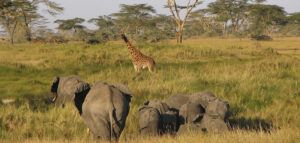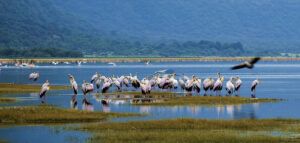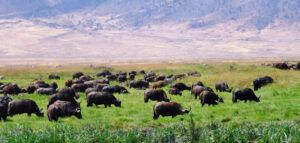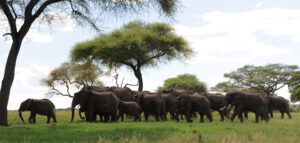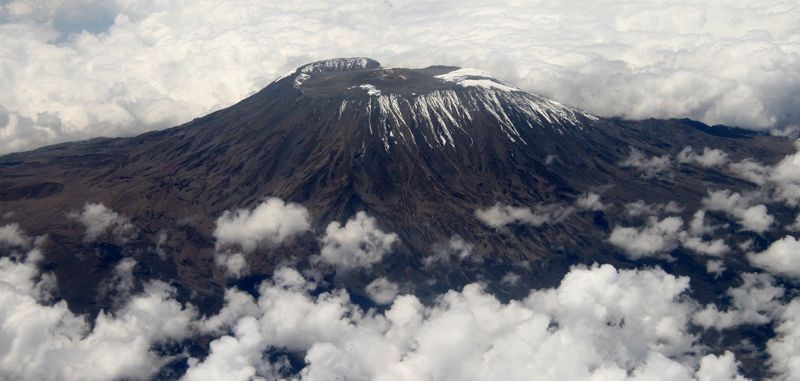
Mount Kilimanjaro is one of the most iconic mountains in the world, standing tall in Tanzania and representing the highest point in Africa. With its snow-capped summit, despite being located near the equator, Kilimanjaro captivates adventurers, nature lovers, and mountaineers alike.
Geography and Climate
Kilimanjaro is a dormant stratovolcano composed of three cones: Kibo, Mawenzi, and Shira. The highest point, Uhuru Peak, is located on Kibo, standing at 5,895 meters (19,341 feet). This mountain is unique because it encompasses a wide range of ecosystems, from tropical rainforests at its base to alpine deserts and icy glaciers near the summit.
The climate of Kilimanjaro varies depending on the altitude. At the base, it’s warm and humid, with rainfall supporting lush forests filled with diverse wildlife. As you ascend, the air becomes cooler, and the terrain shifts to rocky moorlands and barren landscapes, culminating in the icy peak, where temperatures can plummet below freezing.
History and Significance
Kilimanjaro has long been a symbol of adventure and challenge. The first recorded successful ascent was made by Hans Meyer and Ludwig Purtscheller in 1889. Today, it attracts thousands of hikers and climbers from around the world, with many seeking to conquer the mountain as a personal achievement or to raise awareness for various causes.
Beyond its physical beauty, Kilimanjaro holds significant cultural importance. It is often referred to as “The Roof of Africa” and is regarded with reverence by local tribes such as the Chagga, who live on its slopes.
The Trek to the Summit
Climbing Kilimanjaro is a challenging but achievable feat for many adventurers, even those without technical mountaineering experience. There are several routes to the summit, each offering its own unique experience:
- Marangu Route: Known as the “Coca-Cola Route,” it’s the most popular and offers hut accommodation.
- Machame Route: Often called the “Whiskey Route,” it’s more challenging with steeper paths but provides incredible scenic views.
- Lemosho Route: A longer, less crowded route with beautiful landscapes and a higher chance of acclimatization success.
The trek usually takes between 5 to 9 days, depending on the chosen path and the hiker’s pace. Reaching Uhuru Peak is physically demanding, but the reward is unparalleled: breathtaking panoramic views from Africa’s highest point.
Wildlife and Biodiversity
Kilimanjaro is not just about the climb—its biodiversity is also remarkable. The lower slopes are home to elephants, leopards, buffalo, and various primates. As you ascend, you’ll witness a dramatic shift in vegetation, from tropical rainforests teeming with life to unique alpine plants that can survive the harsh conditions near the summit.
Conservation Challenges
Mount Kilimanjaro’s glaciers have been rapidly melting due to climate change. Some estimates suggest that the glaciers could disappear entirely within the next few decades. This melting poses a threat not only to the mountain’s ecosystem but also to local communities who rely on the meltwater for agriculture and daily use.
Planning to Trek Mount Kilimanjaro
Overview of Kilimanjaro’s Routes
There are several routes to the top of Kilimanjaro, each offering different levels of difficulty, scenery, and crowd sizes. We’ll cover each one in detail so you can make the best choice based on your experience and preferences.
Best Time to Trek Mount Kilimanjaro
Weather Considerations
The weather on Kilimanjaro varies dramatically depending on the time of year. The two main trekking seasons—January to March and June to October—offer the most stable weather. However, keep in mind that the mountain has five distinct climate zones, so you’ll experience everything from warm, humid conditions to freezing temperatures near the summit.
Peak Seasons vs. Off-Seasons
While the peak trekking seasons offer the best weather, they also draw the largest crowds. The off-seasons (April-May and November) can be quieter but come with the risk of heavy rains, which can make trails muddy and slippery. It’s all about finding the balance between weather and solitude.
Kilimanjaro Trekking Routes
Marangu Route – The Popular Option
Known as the “Coca-Cola” route, Marangu is the most popular, primarily because it’s the only route with huts for accommodation. It’s one of the shortest routes, but that also makes it steeper, leaving less time for acclimatization. This route is best for those looking for a faster, more straightforward trek.
Machame Route – The Scenic Path
The Machame route is one of the most scenic trails up Kilimanjaro. It offers more gradual acclimatization, making it a better choice for those worried about altitude sickness. However, it’s also longer and more physically demanding than Marangu, so be prepared for a challenge.
Lemosho Route – The Adventurous Journey
For adventurers who want solitude and a diverse landscape, the Lemosho route is a top pick. It’s one of the most beautiful and remote routes, crossing from the western side of Kilimanjaro. The extra days on the trail mean more time to adjust to the altitude.
Rongai Route – The Quiet Trail
Rongai is the only route that approaches Kilimanjaro from the north. It’s less crowded than other routes and is ideal for those seeking a more solitary trekking experience. However, it’s also less scenic in the lower sections.
Umbwe Route – The Steepest Challenge
If you’re an experienced hiker looking for a serious challenge, the Umbwe route is the steepest and most direct path to the summit. It’s a physically demanding trail and should only be attempted by trekkers with prior altitude experience.
Preparing Physically for the Trek
Fitness Requirements
You don’t need to be an elite athlete to trek Kilimanjaro, but a good level of fitness is essential. Your training should focus on building endurance, leg strength, and cardiovascular fitness. Stair climbing, hiking with a weighted backpack, and regular aerobic exercises will help prepare your body for long days on the trail.
Altitude Training and Acclimatization
Altitude sickness is one of the biggest challenges on Kilimanjaro. To minimize the risk, try to spend time hiking at altitude before your trek. If that’s not possible, practice slow, steady ascents and choose a longer route that allows more time to adjust to the thinning air.
Packing Essentials for Kilimanjaro
Clothing for Varied Weather Conditions
Since you’ll be trekking through multiple climate zones, layering is key. Start with moisture-wicking base layers, followed by insulating layers for warmth, and a waterproof jacket for rain and wind. Don’t forget gloves, a hat, and thermal socks for the colder summit days.
Gear and Equipment Checklist
Beyond clothing, essential items include trekking poles (to reduce strain on your knees), a high-quality sleeping bag (rated for cold temperatures), headlamps, and a sturdy backpack. A camelback or water bottle system is critical for staying hydrated on the trail.
Choosing a Guide and Trekking Company
Why a Guide is Essential
Kilimanjaro is a highly regulated mountain, and you can’t climb it without a guide. Guides not only ensure your safety but also help with pacing, spotting early signs of altitude sickness, and providing valuable local knowledge.
How to Choose the Right Company
When selecting a trekking company, look for one that prioritizes safety, has experienced guides, and offers a strong support system (like porters and cooks). Read reviews and consider companies that promote responsible tourism and treat their staff ethically.
Understanding the Costs
Permit Fees and Park Entry
Trekking Kilimanjaro isn’t cheap. Park entry fees, camping or hut fees, and rescue fees are all required and can add up. These costs are typically included in the package price from trekking companies, so be sure to clarify what’s covered.
Trekking Packages and Other Costs
Trekking companies offer packages that range from budget to luxury. The price often depends on the route, number of days, and level of service (such as private versus group treks). Don’t forget to budget for tipping your guides and porters, which is customary on Kilimanjaro.
Acclimatization and Altitude Sickness
Symptoms and Prevention
Altitude sickness can affect anyone, regardless of fitness level. Symptoms include headaches, nausea, dizziness, and difficulty sleeping. To prevent it, climb slowly, stay hydrated, and listen to your body. Some trekkers also take medications like Diamox to aid acclimatization.
How to Acclimate Effectively
One of the best ways to acclimate is by following the “climb high, sleep low” principle—ascend to a higher altitude during the day, but sleep at a lower one. Taking more time on the mountain also improves your chances of a successful summit.
What to Expect During the Trek
Daily Trekking Routine
Most days on Kilimanjaro involve trekking for 4 to 6 hours, with frequent breaks for meals and rest. The pace is deliberately slow to aid acclimatization, and the higher you go, the more challenging the trek becomes.
Meals and Accommodations on the Mountain
Depending on your route, you’ll either sleep in tents or mountain huts. Meals are typically prepared by your trekking team and include a variety of simple but hearty dishes to keep you fueled for the trek ahead.
Wildlife and Scenery
Unique Flora and Fauna on Kilimanjaro
As you climb higher, you’ll pass through several ecosystems, each home to different plant and animal species. The lower slopes are rich with tropical plants, while the alpine desert zone hosts hardy species adapted to the harsh environment.
Changing Landscapes and Ecosystems
From lush rainforests to barren alpine deserts, Kilimanjaro offers an ever-changing landscape that makes the trek feel like an evolving adventure. The final stretch to Uhuru Peak is dominated by glaciers and snowfields, providing breathtaking views.
Staying Safe and Healthy on the Trek
Hydration and Nutrition Tips
Staying hydrated is essential on Kilimanjaro, as the dry mountain air and physical exertion can dehydrate you quickly. Drink at least 3-4 liters of water daily and eat plenty of carbs to fuel your trek.
Managing Trekking Fatigue
The combination of altitude and long hiking days can leave you exhausted. Ensure you get plenty of rest, take breaks when needed, and don’t push yourself too hard, especially on summit day.
Reaching the Summit – Uhuru Peak
The Final Push to the Top
Summit day is the most challenging, with trekkers usually starting around midnight to reach the peak by sunrise. The final ascent is steep and slow, but the breathtaking view at the top makes every step worth it.
What Reaching the Summit Feels Like
Reaching Uhuru Peak is an emotional moment for many trekkers. After days of physical exertion and mental perseverance, standing on Africa’s highest point is a feeling of triumph like no other. The stunning panoramic views are the ultimate reward.
After the Trek – What’s Next?
Rest and Recovery
After your descent, take time to rest and recover. Your body will likely be sore and tired, but a warm shower and soft bed will feel incredible after days on the trail.
Post-Trek Adventures in Tanzania
Many trekkers combine their Kilimanjaro adventure with a safari or a visit to Zanzibar. Tanzania is home to incredible wildlife reserves and pristine beaches, making it the perfect destination to unwind after your trek.
Conclusion: Is Mount Kilimanjaro Worth the Effort?
Trekking Mount Kilimanjaro is no easy feat, but it’s undoubtedly worth the effort. From the diverse landscapes to the feeling of accomplishment at the summit, this journey offers an experience of a lifetime. Proper preparation is key to a successful and enjoyable trek, so plan ahead, train hard, and get ready for the adventure of a lifetime.



